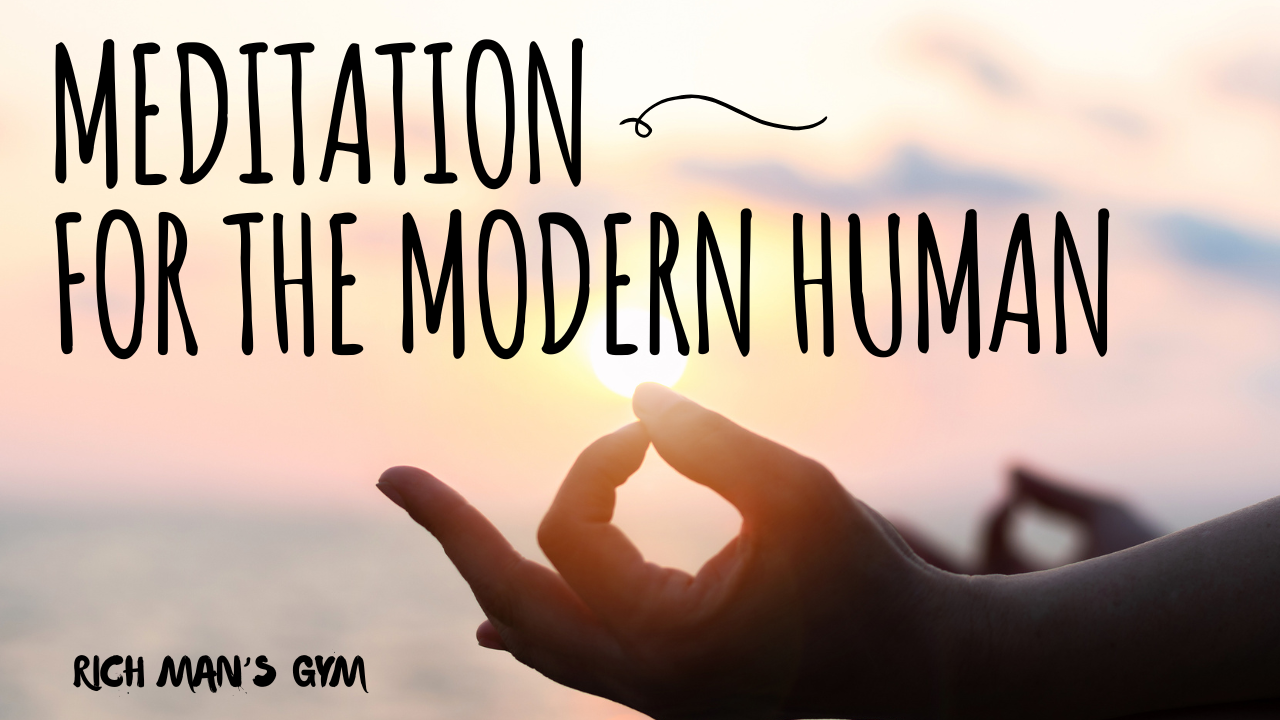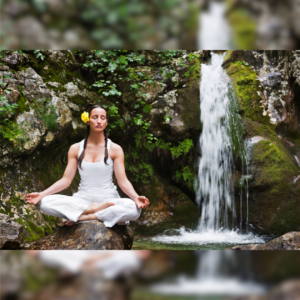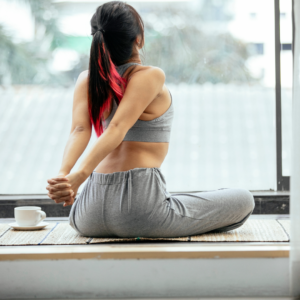
Meditation for the Modern Human: A Beginner’s Guide
In today’s fast-paced world, stress, anxiety, and information overload are constant companions. Amid this chaos, many are searching for a moment of peace—a way to tap into inner strength and calm. Meditation for the modern human is not just a trend; it is a lifeline for those seeking emotional balance and mental clarity. In this comprehensive guide, we will explore three key meditation practices: mantra meditation, japa meditation, and the Wim Hof breathing technique. Whether you’re a complete beginner or someone looking to deepen your practice, this guide is designed to help you find serenity in the midst of modern chaos.
1. Understanding Meditation for the Modern Human
Meditation has evolved over centuries from ancient spiritual practices into accessible tools for improving mental and physical health. For the modern human, meditation is a versatile practice that can help manage stress, enhance focus, and cultivate a sense of overall well-being. It is more than just sitting quietly—it is about connecting with your highest self, your higher power and the universe on a deeper level. It’s about understanding your inner workings, and ultimately transforming your life.
The Need for Meditation Today
In an era dominated by digital distractions, our minds rarely get the downtime they desperately need. Constant notifications, multitasking, and an unending barrage of information can lead to burnout. Meditation offers a much-needed respite, providing a space where you can pause, breathe, and reconnect with your inner self.
- Improved Focus: Regular meditation practices sharpen your mind, making it easier to concentrate on tasks.
- Stress Relief: Meditation techniques help lower cortisol levels, reducing the physiological effects of stress.
- Emotional Balance: By fostering mindfulness, meditation can help regulate emotions and promote a more balanced perspective.
2. The Power of Mantra Meditation
 Mantra meditation is one of the oldest and most effective meditation practices known to humanity. A mantra is a word, sound, or phrase that is repeated either aloud or silently during meditation. The repetition of a mantra helps focus the mind and shift attention away from distracting thoughts.
Mantra meditation is one of the oldest and most effective meditation practices known to humanity. A mantra is a word, sound, or phrase that is repeated either aloud or silently during meditation. The repetition of a mantra helps focus the mind and shift attention away from distracting thoughts.
What is a Mantra?
A mantra is more than just a set of words; it carries a vibration and energy that can impact your state of mind. Mantras have been used for centuries in various spiritual traditions to invoke a sense of calm, clarity, and connection to a higher power.
Benefits of Mantra Meditation:
- Enhanced Concentration: Repeating a mantra creates a rhythmic pattern that helps your mind focus.
- Stress Reduction: The vibrational quality of mantras can soothe the nervous system and induce relaxation.
- Inner Peace: Over time, the steady repetition of mantras can lead to profound inner calm and clarity.
How to Practice Mantra Meditation
- Find a Quiet Space: Choose a peaceful spot where you can sit comfortably without distractions.
- Select Your Mantra: Pick a mantra that resonates with you. It can be a traditional sound like “Om” or a personal phrase that inspires positivity.
- Focus on Repetition: Close your eyes, take a deep breath, and begin repeating your mantra either out loud or silently.
- Allow Thoughts to Pass: If your mind wanders, gently bring your focus back to the mantra without judgment.
- End with Gratitude: After your session, take a moment to express gratitude for the calm and clarity you experienced.
PERSONAL EXPERIENCE WITH Mantra meditation has been a powerful way to align my mind, body, and spirit, making it a perfect starting point for me when I was new to meditation. My entry point was this album called Reaching In by Larisa Stow and the Shakti Tribe. On it is the Ganesh Mantra. Ganesh in the Hindu faith is the remover of obstacles. At the time of my discovery, Jack Daniels was my obstacle. This mantra and this album was an invaluable part of my sobriety journey.
3. Exploring the Depths of Japa Meditation
Japa meditation is a practice closely related to mantra meditation, but with a distinct emphasis on repetition using a string of beads known as a mala. The word “japa” comes from Sanskrit, meaning “repetition” or “recitation.” This form of meditation involves the repetitive chanting or mentally reciting of a mantra, often accompanied by the tactile experience of moving beads through your fingers.
The Role of the Mala
 A mala typically contains 108 beads and serves as a tool to keep count of the repetitions. The tactile sensation of moving each bead enhances concentration and helps maintain focus, allowing you to enter a meditative state more deeply.
A mala typically contains 108 beads and serves as a tool to keep count of the repetitions. The tactile sensation of moving each bead enhances concentration and helps maintain focus, allowing you to enter a meditative state more deeply.
Benefits of Japa Meditation:
- Enhanced Mindfulness: The physical act of counting beads anchors you in the present moment.
- Deeper Spiritual Connection: Repetition of sacred mantras can help forge a stronger connection to your inner self and the universe.
- Emotional Healing: Japa meditation can be a soothing practice that helps release pent-up emotions and foster inner peace.
How to Start Your Japa Meditation Practice
- Select a Mala: Choose a mala that feels comfortable in your hand. It can be made from various materials like wood, seeds, or gemstones.
- Choose Your Mantra: Decide on a mantra that resonates with your intentions. Whether it’s a traditional mantra or a personal affirmation, ensure it carries meaning for you.
- Begin the Practice: Sit in a quiet, comfortable position. Hold your mala in your right hand, and as you recite your mantra, move each bead with your fingers.
- Set a Rhythm: Let the movement of your fingers and the sound of your mantra create a rhythm that soothes your mind.
- Finish with Reflection: Once you have completed the cycle (108 repetitions), take a moment to sit in silence and reflect on your experience.
My own personal experience with Japa meditation. Japa not only deepened my meditation practice but it also integrated more physical movement and tactile stimulation, making it a holistic approach to mindfulness. Spring boarding off the Ganesh Mantra I found The Lake Shrine in Pacific Palisades to be a center of deep peace and solitude where I could as Wayne Dyer put it, get into the gap. This is where I got my first pair of Mala beads too.
Mala beads which are about 800 years older than Mary the Mother of Jesus are very similar to the Rosary Beads from my Catholic upbringing. A faith that I had turned away from for many years but have, since 2022, re-embraced. There is something highly spiritual about repetition, the frequency of the sounds and the space between those sounds that quiets the minds, souths the soul and deepens my connection with the divine.
4. The Incredible Wim Hof Breathing Technique
When most people think of meditation, they might imagine quiet sitting or repetitive chanting. However, the Wim Hof breathing technique offers a dynamic and invigorating approach to meditation that incorporates elements of controlled breathing, cold exposure, and mindfulness.
Who is Wim Hof?
 Wim Hof, also known as “The Iceman,” has gained worldwide recognition for his extraordinary ability to withstand extreme cold. His method combines deep breathing exercises with cold exposure, resulting in improved mental and physical resilience.
Wim Hof, also known as “The Iceman,” has gained worldwide recognition for his extraordinary ability to withstand extreme cold. His method combines deep breathing exercises with cold exposure, resulting in improved mental and physical resilience.
Benefits of Wim Hof Breathing:
- Increased Energy: Deep, rhythmic breathing boosts oxygen levels in your body, resulting in heightened energy.
- Enhanced Immune Function: Research suggests that the Wim Hof method can positively impact your immune system.
- Stress Reduction: The combination of focused breathing and controlled exposure to cold helps manage stress and anxiety.
- Improved Mental Clarity: The method fosters a deep sense of presence, enhancing concentration and focus.
How to Practice the Wim Hof Breathing Technique
- Find a Comfortable Place: Sit or lie down in a safe, comfortable space. Ensure you are not exposed to cold temperatures immediately.
- Begin with Deep Breaths: Take 30-40 deep breaths in quick succession. Breathe in fully and exhale without forcing the air out.
- Hold Your Breath: After the final exhalation, hold your breath for as long as you comfortably can.
- Inhale Deeply and Hold: When you feel the urge to breathe again, take a deep breath in, hold it for 15 seconds, and then release.
- Repeat: Repeat the cycle for three to four rounds, gradually increasing the duration as you become more comfortable with the practice.
My personal experience with the Wim Hof breathing technique has been a potent practice that’s empowering for me to tap into my body’s natural resilience, it has opened up a new dimension of mental and physical well-being for me and is part of my morning ritual. During the breath holds is where I practice mantra and japa meditation. Currently, during breath holds I am saying The Lord’s Prayer in silence and as slowly as I possibly can.
5. How to Choose the Right Meditation Practice for You
Choosing the right meditation practice can feel overwhelming, especially when presented with so many options. The key is to experiment and listen to your body and intuition. Here are some pointers to help you decide:
- Start Simple: If you’re new to meditation, beginning with mantra meditation can be less intimidating. The repetitive nature of mantras offers a straightforward method to quiet the mind.
- Embrace the Tangibility: If you prefer a more tactile approach, japa meditation with a mala may be ideal. The physical movement can help ground your practice.
- Seek Physical Engagement: For those who want a more active form of meditation, the Wim Hof breathing technique offers both mental and physical benefits. Also, this is for another post all together but look to Yoga, Tai Chi and Qi Gong as additional forms of active meditaition.
- Consider Your Goals: Are you looking to reduce stress, enhance concentration, or build physical resilience? Your objectives will help guide you toward the practice that best meets your needs.
- Experiment and Adapt: Remember, there is no one-size-fits-all approach to meditation. Feel free to blend practices or switch between them based on your daily needs and experiences.
By understanding your personal needs and experimenting with different techniques, you can find a meditation practice that truly resonates with you.
6. Step-by-Step Guide to Starting Your Meditation Journey
Taking the first step into meditation might feel daunting, but breaking it down into simple steps can make the process manageable and rewarding.
Step 1: Create a Dedicated Space
 Designate a quiet corner in your home where you can meditate regularly. This space should be free from distractions and feel inviting and calming.
Designate a quiet corner in your home where you can meditate regularly. This space should be free from distractions and feel inviting and calming.
- Personalize Your Space: Add elements that bring you joy—candles, soft lighting, or even a small altar with meaningful objects. Additionally, doing this is nature is fantastic.
- Maintain Consistency: A dedicated space helps signal to your mind that it’s time to relax and focus.
Step 2: Set a Routine
Establishing a regular meditation routine is key to reaping the benefits of your practice.
- Start Small: Begin with just 5-10 minutes per day and gradually increase the duration as you become more comfortable.
- Choose a Time: Whether it’s early in the morning or before bed, select a time that fits seamlessly into your daily routine. Both is better… just sayin’
Step 3: Focus on Your Breath
Your breath is the anchor that grounds your meditation practice. Start by simply observing your breathing.
- Deep Breathing: Inhale slowly through your nose and exhale through your mouth. Focus on the rhythm and sensation of each breath.
- Mindful Observation: Notice the rise and fall of your stomach and chest without trying to control your breathing.
Step 4: Incorporate Your Chosen Technique
Decide whether you want to use mantra, japa, or the Wim Hof breathing technique as your primary method. Spend a few sessions exploring each method to see which one resonates with you the most.
Step 5: Reflect and Journal
After each session, take a few minutes to reflect on your experience. Journaling your thoughts can help track your progress and highlight any breakthroughs or challenges.
- Record Insights: Write down any thoughts, feelings, or realizations that come to you during meditation.
- Set Intentions: Use your journal to set small goals or intentions for your next session.
By following these steps, you can gradually build a meditation practice that fits your lifestyle and nurtures your overall well-being.
7. Integrating Meditation for the Modern Human into Your Daily Routine
Meditation is not just a practice confined to a quiet corner of your home; it’s a way of life. Here’s how you can weave meditation into the fabric of your everyday activities:
Morning Rituals
- Start Your Day Right: Begin your morning with a brief meditation session to set a positive tone for the day. Whether it’s 5 minutes of mantra recitation or a few rounds of deep Wim Hof breaths, a calm start can influence your entire day.
- Mindful Moments: Incorporate mindfulness into your morning routine by paying full attention while making your coffee or taking a shower.
During the Workday
- Take Short Breaks: Use short, mindful breaks to recharge. A minute of deep breathing or a few repetitions of your chosen mantra can help reduce work stress.
- Mindful Transitions: Transition between tasks with mindfulness. A quick, intentional pause can improve focus and productivity.
Evening Wind-Down
- Reflect on the Day: End your day with a meditation session that allows you to process the events of the day and prepare for restful sleep.
- Unplug and Unwind: Ditch digital distractions in the evening. Instead, immerse yourself in the calming practice of japa or a slow, deliberate breathing session.
By integrating meditation into your daily routine, you can maintain a consistent practice that continually nourishes your mind, body, and spirit.
8. Overcoming Challenges and Misconceptions
Starting a meditation practice is a journey that comes with its own set of challenges and common misconceptions. Here are some hurdles you might face and how to overcome them:
Misconception 1: “I Need to Clear My Mind Completely”
Many beginners believe that meditation requires a completely blank mind. The truth is, it’s perfectly natural for thoughts to arise. The goal is not to eliminate thoughts but to observe them without judgment.
- Tip: When thoughts emerge, gently acknowledge them and return your focus to your breath or mantra.
Misconception 2: “I Don’t Have Time for Meditation”
Hogwash. Yes, modern life is busy, and finding time can be challenging. However, even a few minutes of meditation can have a significant impact on your well-being.
- Tip: Start with short sessions and gradually build up. Incorporate meditation into routine activities like your morning routine or during short breaks at work.
Misconception 3: “I’m Not Good at Meditating”
Impossible. It’s common to feel like you’re “doing it wrong” if you don’t experience immediate results. Remember, meditation is a skill that improves with practice.
- Tip: Be patient with yourself and celebrate small victories. Consistency is key to long-term benefits. Most important part is to start and then be frequent.
Overcoming Distractions
Distractions are inevitable, especially when you’re just starting out.
- Create a Ritual: Having a set routine or ritual before meditation can signal to your brain that it’s time to focus.
- Mindfulness Techniques: Use mindfulness techniques to gently bring your attention back whenever your mind wanders.
Addressing these challenges with compassion and persistence will help you develop a resilient meditation practice that can withstand the tests of modern life.
9. The Science Behind Meditation
Modern research has begun to validate many of the benefits that ancient meditation practices have long claimed. Studies have shown that regular meditation can lead to measurable changes in brain structure and function.
Neurological Benefits
- Increased Grey Matter: Regular meditation has been linked to increased grey matter density in areas of the brain responsible for memory, empathy, and emotional regulation.
- Enhanced Neural Connectivity: Meditation promotes better communication between different regions of the brain, which can lead to improved problem-solving and creativity.
Physical Health Benefits
- Reduced Stress Levels: Meditation has been shown to lower cortisol levels, which helps reduce stress and improve overall health.
- Improved Immune Function: Some research suggests that mindfulness practices can boost immune response, making the body more resilient to illness.
- Better Sleep Quality: Meditation can help regulate sleep patterns, leading to more restful and restorative sleep.
Emotional and Psychological Benefits
- Increased Emotional Resilience: Regular practice can help you better manage emotions and respond to stress in a healthy way.
- Enhanced Well-Being: Meditation is linked to higher levels of happiness and life satisfaction, as it encourages a mindful approach to daily challenges.
Understanding the science behind meditation can provide additional motivation and reassurance that your practice is not only spiritually fulfilling but also beneficial for your overall health.
10. Embracing the Emotional Journey of Meditation
Meditation is as much an emotional journey as it is a mental or physical one. It certainly has been for me. As you begin to incorporate practices like mantra meditation, japa, or the Wim Hof breathing technique into your life, you might notice real shifts in your emotional landscape.
Facing Your Inner Self
 Meditation provides a safe space to explore your inner world. Emotions that may have been suppressed or ignored can come to the surface. Instead of resisting these feelings, acknowledge them with compassion and curiosity.
Meditation provides a safe space to explore your inner world. Emotions that may have been suppressed or ignored can come to the surface. Instead of resisting these feelings, acknowledge them with compassion and curiosity.
- Emotional Healing: Over time, this process can lead to emotional healing and a deeper understanding of yourself.
- Increased Compassion: As you become more attuned to your own emotions, you naturally cultivate greater empathy and compassion for others.
Building Emotional Resilience
Developing a regular meditation practice can build your emotional resilience, helping you navigate life’s ups and downs with grace and calm.
- Mindful Reflection: Regular meditation allows you to process your emotions mindfully, preventing them from overwhelming you.
- Stress Management: By reducing the intensity of emotional reactions, meditation creates space for thoughtful responses rather than impulsive actions.
11. Meditation as a Lifestyle: Beyond the Cushion
The practices of mantra, japa, and Wim Hof breathing extend far beyond the moments spent in meditation. They can transform your daily life by fostering a more mindful, intentional approach to every moment.
Integrating Mindfulness into Everyday Activities
Courtesy of The Way Of The Peaceful Warrior, mindful meditation had a profound impact on me and helped me to be more present in everyday life.
- Mindful Eating: Savor your meals, focusing on the textures, flavors, and aromas of your food. This practice enhances gratitude and reduces stress.
- Mindful Movement: Whether it’s a walk in the park or a session of yoga, bring mindfulness into your physical activities.
- Mindful Relationships: Practice active listening and empathy with friends, family, and colleagues to nurture more meaningful connections.
Creating a Supportive Community
Meditation can often more enriching when shared with others. Look for local meditation groups or online communities where you can share experiences, learn new techniques, and find encouragement on your journey.
- Workshops and Retreats: Consider attending meditation workshops or retreats. Immersive experiences can deepen your practice and connect you with like-minded individuals.
- Online Forums: Participate in online discussions, share your progress, and ask questions. A supportive community can help keep you motivated and inspired.
By embracing meditation as a lifestyle, you transform not only your moments of stillness but your entire approach to living.
Conclusion
Meditation for the modern human is a beacon of hope in an often chaotic world. Whether you are drawn to the rhythmic chanting of mantra meditation, the tactile mindfulness of japa meditation, or the invigorating power of the Wim Hof breathing technique, each practice offers unique benefits that contribute to a more balanced, peaceful life.
This guide has taken you on a journey through various meditation practices, exploring their historical roots, practical benefits, and scientific validations. As you begin or deepen your meditation practice, remember that the journey is personal and ever-evolving. Embrace every moment of stillness, every deep breath, and every heartbeat as a step toward greater clarity and inner peace.
Your journey toward a more mindful life starts today. Remember, meditation is not about perfection; it’s about progress, self-discovery, and nurturing your inner well-being. So, set aside your doubts, take a deep breath, and begin this transformative practice.
Ready to start your meditation journey? Share your experiences in the comments below. Whether you have questions, tips, or a personal story to share, I’d love to hear from you. Embrace the peace, embrace the clarity, and let meditation guide you to a more balanced and fulfilled life.
Embrace these practices, share this guide with fellow seekers, and remember: every step you take toward mindfulness is a step toward a brighter, calmer future. Happy meditating!
